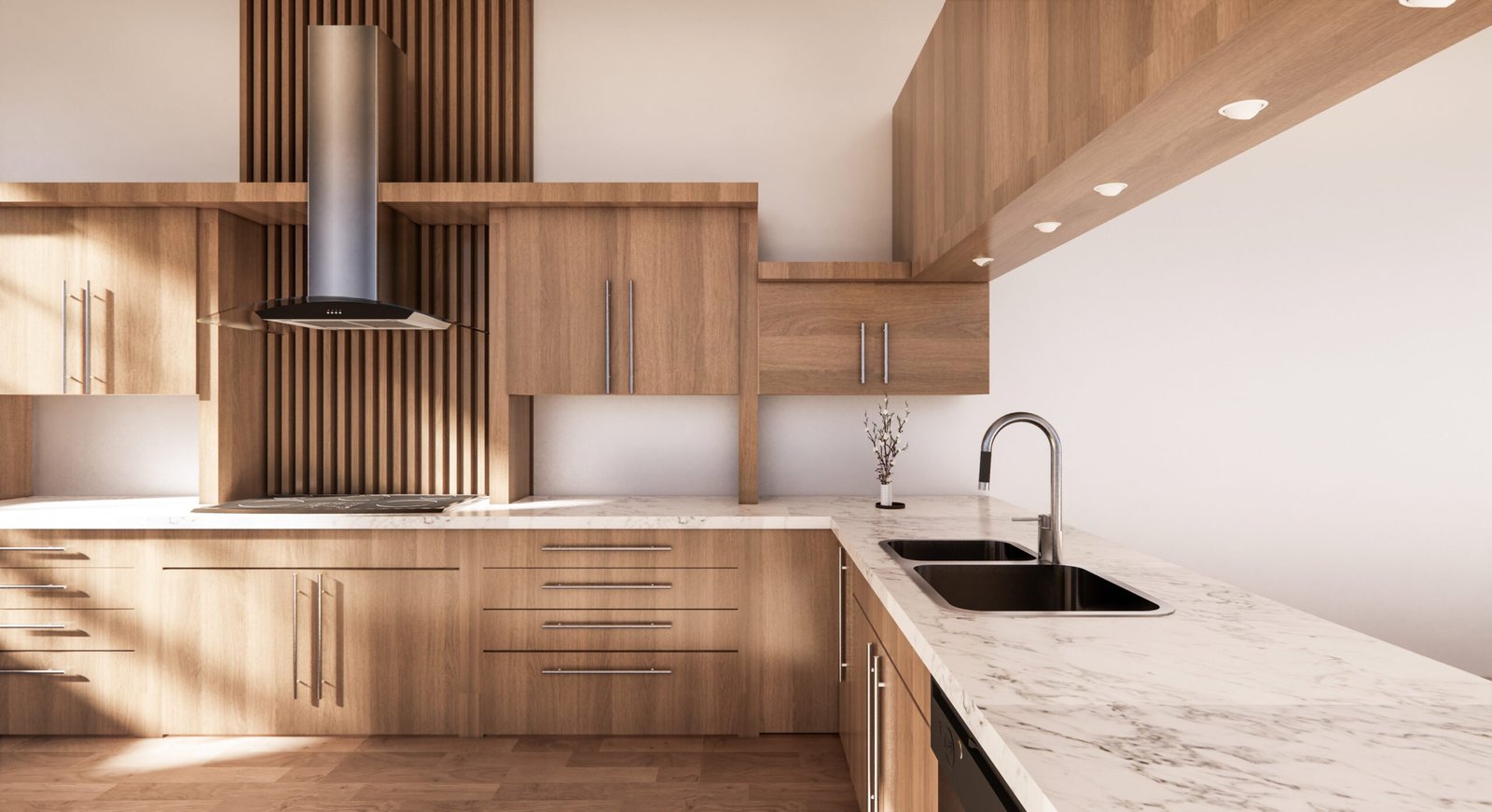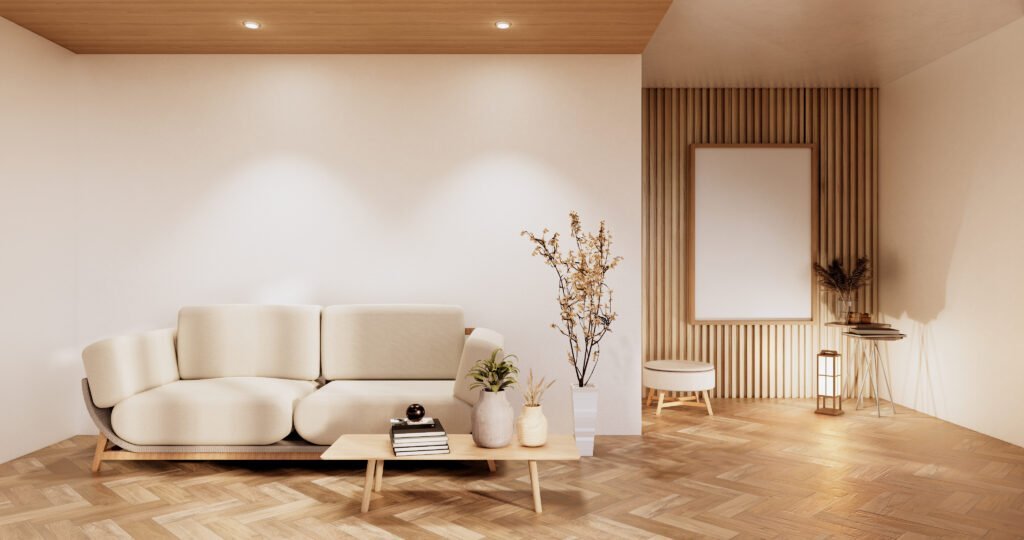Having a large area of white or cream in a room will instantly make it brighter. The design and feel of a room can vary depending on how you use these areas, again composition is really important especially when incorporating colour and texture into a primarily white space.
This article details some of the different ways you can use white in your space, with each one yielding a different result. Having a certain ratio of white applies to every one of the following points, here are some safe ratios for balancing white with colour and texture in your space: 7:3, 3:7, 1:1, 3:3:3 (the rule of thirds, or the golden ratio, if often a safe bet)
1. Breaking up the walls

Having all white walls can be quite intense, a way to offset this would be to break up the white space with wall-bound furniture – like cupboards, mirrors and shelves.
By doing this you can divide the white areas into different shapes and sizes to create an interesting composition. You could add in a single texture or colour, like the wooden furnishings shown in the example above, or you could add in more colours and textures.
Taking this one step further, you could play around with the ratio of white to other light colours, darker colours, textures, reflective surfaces and more.
2. Using the white as a frame

Something art galleries discovered a long time ago but is only recently being used in a more domestic setting. A great use for white walls is highlighting a contrasting piece in the room, be it a piece of art, unique furniture or an interesting house plant.
To prevent the white from being too overwhelming, having a textured floor, some minimal wall décor and some contrasting black elements within the room, as seen in the example above, could be a good move.
If you’d like to take this a step further, try adding a little bit colour that corresponds with the centre piece of your room. If we’re using the example above, say a few ornaments on the window sill that are the same colour as the peach in the graphic art piece.
3. Using reflections

Now we are truly diving into the art space, however this technique can be quite subjective depending on what kind of look you’re going for. Using reflective surfaces can be a great option to increase brightness in a smaller space or if natural light is lacking. It can also be great for any interesting lighting set up, especially with coloured lights.
There are many options when incorporating reflections into a room: mirrors at different levels, unique furniture as seen above, glass doors or features, painting designs with reflective paint which opens up even more opportunities.
Having a hard floor allows for reflections to be cast by floor mirrors or mirror-like furniture, as seen above. I really enjoy this little feature.
4. A minimalistic approach

A popular use of white walls is matching it with a specific wooden texture and adding white accoutrements, such as the white fluffy carpet, to create a rather soft and comforting space.
This look is achieved by matching wood types, or at least the appearance. For example, if your floorboards were made from a bright oak, you’d find furniture or other decorations that were also made from bright oak, or at least looked similar to give some cohesion to the room.
Here both the chair and table match the flooring, however the whole seating area is on top of a white carpet to split up the wooden elements. The addition of these pale green plants gives the space interest, so it can be minimal without being dull.
5. Repeating Motifs

I really like this room enjoy this room as they’ve nailed the composition, in the photo at least. You’ll notice there is a lot of white décor here: the bed sheets, the poster curtain, the fan, the woven throw on the table, the floor and walls; but it does not feel overwhelming.
Dark colours are speckled all around the room, subtle divvying up the white and giving it a flowing form. Also all the whites in this room are not all the same and none of them are the stark titanium white we all know, instead you have all of these subtle tones spreading from the sheets to the walls to the floor.
The use of pots as a motif here is interesting as they are neutral enough to not immediately draw the eye but textured and different enough from their surroundings to break the space up even more. Even the simple act of having a collection of pots set on a rug and a matching set on the bare floor, creates these loose area boundaries in an open space to prevent it from feeling gaunt and bare.
6. Everything on the inside

If you have all white walls, then a neutral and natural colour palette is a safe bet any day. By adding coordinated furnishings and décor, you’ll create a space that has this cluttered cosy feel while retaining the illusion of a bigger room brought on by the bright white.
This is a great option of you wanted to steer clear of the clean modern look and want to go for something a little more rustic and loved.
If you’re interested in this technique then these natural summer palettes may give you some ideas.
7. Glowing all around

This room has a very luxurious feel but also has a sense of depth due to the different types of light the designer has included. From the windows’ side, you have this cool natural light emanating from the translucent curtain paired with the subtle dots of light from the ceiling. The feature wall does wonders as it has it’s own warm light source as well as a mirror which brightens the room further. The mirrored coffee table is a nice touch.
I have to mention the accent wall again. The white shelves are seemly emerging from the surrounding walls, simultaneously covering and highlighting the patterned wallpaper beneath as well as the decoration lining the shelves.
8. Focus on the furniture

Inserting white furniture into a room that is mostly mid-tone can give pops of light, even when natural lighting is at a minimum. Choosing matching whites would be ideal for this but I know it isn’t always possible and often you have to eyeball it.
Bigger pieces of furniture like sofas, chairs, coffee tables, doors and rugs would be great to build around with smaller items like plant pots or shelves.
9. Gradient from the ground up

An interesting technique if you have a specific colour and texture palette in mind when designing you space. Say if you have a coloured carpet, rug or wooden flooring, like in the example above, you’d co-ordinate the other elements of your space in such a way that it looks as if the colours and textures you chose are climbing up the room yet diminish at he same time.
In this example, the quite vibrant wooden flooring is covered by a woven rug. A level up from this, you have the cinnamon blanket and pillows on the bed as well as a woven throw and similarly coloured accent cushions. However, the bed is not fully covered by colours and textures, like the floor is. A level up from that we have the hanging picture which has a few of the colours from the bed and floor but is mostly surrounded by white wall. Then on the top level, you get a little pop of colour from the light shade.
10. No floor, wall or ceiling is safe

Might as well finish it off with a classic, accent walls, floors and ceilings. Of course, creating an accent wall is by far the most easily achieved of the three but all can yield some really interesting design opportunities, especially if they’re used simultaneously.
As seen in the example above, using texture for these accents can be really interesting. On the the other hand, if you enjoy a slightly more artistic touch, you could always commission a mural for you wall and work with the artist to ensure you’re vision is reality.
I hope you enjoyed this article, if there’s any other decoration ideas you’d like to see or have any suggestions for the website, let me know in the comments.
– Many thanks, Arryn


Leave a Reply